
Website founded by
Milan Velimirović
in 2006
17:49 UTC


| |
MatPlus.Net  Forum Forum  General General  Thoughts on the Study of the Year... Thoughts on the Study of the Year... |
| |
|
|
|
|
You can only view this page!
| | Page: [Previous] [Next] 1 2 | | (1) Posted by Kevin Begley [Wednesday, Oct 28, 2009 17:13]; edited by Kevin Begley [09-10-28] | Thoughts on the Study of the Year...
A friend tells me, in good humor, that the judges may have a few drinks before they vote on which problem is to be named, "Study of the Year."
Furthermore, he says their purpose may be to make studies more popular, rather than actually decide what is the "best" study for any given year (if true, the name of the award should be changed, to better reflect its value).
I don't mind the specific winner, for 2008 -- even though it might be considered a mere extension of a well known idea, one cannot help but admire the creative extension here!! What does bother me is the duals not mentioned in the solution given.
Velimir Kalandadze
1st Special Prize Nona JT, 2008
 (= 4+3 ) (= 4+3 )
+ (4+3)
1. Qf4+ Ke6(Ke7) 2. Qf7+ Kxf7 3. d8=S+ Kf6+ 4. Sxb7 Ke5 5. Kg6 Kd4 6. Kf5 Kc3 7. Ke4 Kb2 8. Kd3 Kxa2 9. Kc2 Ka1 10. Sc5 Ka2 11. Sd3 Ka1 12. Sc1 a2 13. Sb3#
Have composition standards so severly eroded for this genre?
My friend jokes that the solution essentially ends after 4.Sxb7 -- I might agree, if there were some study which could be sited, that explains the problem from this point forward. However, it is not possible to site such a study, for reasons I will soon explain...
Technically, I believe the solution is fine until 9.Kc2 -- but a serious dual occurs after 9...Ka1, so the solution must end after white's 9th move.
For clarification: a problem has a dual if, when digrammed at any intermediate node of its solution, for the same genre, it would be considered "cooked."
It is not possible to site any study (a directmate perhaps, but not a study!), because the dual contained in this study would not be ignored (notwithstanding the fact that these judges ignored it, for whatever reasons/mercies).
It's obvious that the solution does not end well after white's 9th move, because the central idea of the problem has not yet been fully expressed (e.g., consider the complete rookie, who remains mystified how this KNkp position can be won for white!).
No matter how much the judge may want to compensate for the unforunate shortcomings here, the solution cannot continue beyond white's 9th move.
[Edit: it is preferable to simply state in the solution, .... 9.Kc2 wins (in fact, mates in 5 moves), and then, seperately, give the solution to the mate in 5.]
For the benefit of anybody who might question the validity of my dual claim...
It is true that the EGTB gives 10.Sc5 as the fastest path to mate (4 moves), but there is an alternative to achieve the aim (win): 10.Sa5 mates in 6.
So, what kind of dual is 10.Sa5?
It's not the kind often dismissed as a "time-waste-dual," because after 10...Ka2, White has "independant" options (which are not mere delays in bringing the Knight to c5, nor are the ensuing strategies precisely identical to the solution provided).
Conclusion: this is a serious dual (and flaw) -- not the minor kind (which could be excused, no matter whose name is above the diagram).
Disclaimer: this genre seems to *sometimes* overlook serious duals (in the interest of their own interests, I suppose), so it's not entirely fair to single out this study.
Somebody will attempt to argue that the final positions are all the same, so anything slower may be viewed as a mere time-waste.
However, such an argument would be the real time-waste -- such a philosophy would allow rampant duals in any problem with only one practical mate/stalemate position (not an infrequent occurence). Essentially, this would reduce endgame studies to something much closer to the popular misconception of what they are: a quest to find subjective "best" moves.
A slower path to the final mate is never to be considered a legitimate reason to dismiss a dual in an endgame study.
This award, therefore, does not well serve the genre -- in fact, it helps accelerate an already noticeable deterioration in composing standards here!
Why compose long directmates when the standards are so much lower for studies (bad duals ignored) and selfmates (bad keys ignored)?
When capacity is reduced by high standards, so too goes output.
This explains why many exceptional composers, working in intensely stringent genres, never get a fair aknowledgement (or representation) for their contributions to this artform.
Points earned in some genres cannot compare with points earned in others (nevermind that studies earn more points anyway!).
Today there is not one FIDE Album -- there is one binding of 9 seperate albums (the #2 album, #3 album, #n album, study album, h#2 album, h#n album, s# album, fairy album, and the retro album).
Each genre has a unique selection process -- does anybody bother to compare whether the problem rejected from one genre was better than the problem accepted from another?
If the genres cannot police themselves, and our delegates provide no equitable remedy (via secret balloting), perhaps all titles should be genre-based.
| | | (2) Posted by Sergiy Didukh [Thursday, Oct 29, 2009 10:16] |
Awful choice. A slap in the face of every study composer.
I've got only one explanation why this happened.
Because of blind respect! The respected Englishman J.Roycroft offered this childish combination to choose as Study of the Year 2008. The surprised delegates of the studies sub-committee looked at each other with a question written in their rounded eyes: "Is the old man in his mind?" (joke). But so as not to offend the respected man they vote 'for'.
I'd like not to see this study republished in chess magazines as the one which promotes study composition. Obviously, it doesn't. Neither it reflects the level of studies (which is high) in 2008.
The way of choosing Study of the Year is not good.
| | | (3) Posted by Michael McDowell [Thursday, Oct 29, 2009 12:12] |
You point is of course a fair one Sergiy and one doubtless shared by many. It is a pity that you didn't choose to make it in a more measured way. I find your accompanying comment, joking or otherwise, very patronising. Few people have done as much as John Roycroft to promote studies, and he deserves better (as do those who voted for the study).
I am neither a study composer nor a strong player. My contact with studies is through solving competitions, (where they are by far my weakest round) and as a subscriber to EG. Most of the studies in EG leave me cold. Too many have rambling openings or resolve into database positions. Many are highly ingenious, but far beyond the capacities of the average solver. For entertaining studies I would much rather dip into one of the classic books, e.g. the Soviet collection of 1955.
I can understand that to a top class composer the chosen study is extremely lightweight, but it seemed to me that with its natural position it was quite suitable for the purpose of promoting studies. If you want to show a beginner what entertaining possibilities the game provides you show them Morphy v the Count and Duke, not an Anand masterpiece. Similarly you promote problems to players with something like Anderson's Il Secolo Meredith cross-checker, not an example of combinative separation.
I showed the study to a group of players at a local school (average age 11). Their delight when they finally found 2.Qf7+ was a joy to behold. When I told them that they had to look further since the black king could go after the white pawn they got a second big surprise when it dawned that you can actually mate with just a knight. There is a group of children who are now aware of the existence of studies and that they can show ideas which they will probably never see in a game. I think that here is one case where studies obviously have been promoted.
| | | (4) Posted by Sarah Hornecker [Thursday, Oct 29, 2009 13:11] |
Well, here's the study I would show to beginners (and I always feel joy when I can quote it since it also was the first study I saw).
 (= 2+2 ) (= 2+2 )
G.E. Barbier & F. Saavedra
Weekly Citizen (Glasgow), May 1895 (version)
White to move and win
1. c7
How is black supposed to do something against the white pawn? Queen vs. rook is obviously won.
1...Rd6+!
Careful with the field of the white king! 2.Kc5? Rc1 and draw.
2.Kb5! Rd5+
Perpetual check would be a draw so white must have a destination for his king.
3.Kb4 Rd4+
Sadly here's a dual minor
4.Kc3 Rd1 or 4.Kb3 Rd3+
White seems to win now.
5.Kc2
A quite easy manoeuvre. The white pawn is unstoppable now. But - this doesn't mean black has no resources left.
5...Rd4!!
A devilish trap! 6.c8Q Rc4+ is stalemate. White also can't do anything good with his king. So has black secured the draw?
Well, rook versus rook is always drawn.
Or is it?
6.c8R!!
Incredible! For one moment, the material is fully equal. The only white advantage is the bad position of the black king. White threatens checkmate by 7.Ra8+ and RxR. There's only one way to defend this checkmate.
6...Ra4
The white threat is parried, rook versus rook is drawn. What went wrong? After all, white is supposed to win.
Well, he has one last trick.
7.Kb3!
Again white threatens checkmate, but now also the black rook is attacked. Black has no defense against both threats so white wins rook and game.
A delicious fight with nice points on both sides, yet in a lightweight position with a minimum of material.
Clearly the study of the year 1895! And that of all other 115 years since then!
| | | (5) Posted by Sergiy Didukh [Thursday, Oct 29, 2009 17:18] |
Dear Michael, you sound like it was you who suggested Mr.Roycroft this study. Always ready to defend the choice of the respected man even if he is not right. Notice that you have already lost your freedom. You’re repeating the same hypnotizing things about how players or children react to the study of the year shown to them. I am always thrown this argument but am not beaten with it. Most players are thirsty men in composition. The Study of the Year is a cup of water. This explains their reaction to it. But poor men don’t know about juice or wine. They are glad they are given water. This time even water was a bit salty with a dual.
I won’t go for an example of ‘juice’ as far as Siegfried did. Take for example this nice tactical study by G.Sonntag from Die Schwalbe 2007-8, 1st prize.
 (= 5+5 ) (= 5+5 )
Win
1.Kc2 Ra4 2.Na5! Rxa5 3.Rb4 Ra8 4.b7 Bf5+ 5.Bxf5 Rc8+ 6.Rc4
6.Kb3? Rc3+ 7.Kxc3 stalemate.
6...Rxc4+ 7.Kb3 Rf4 8.b8Q Rf3+ 9.Bd3!
9.Kb4!? Rxf5 10.Qh8+ Kb1 11.Qh1+ Kb2 12.Qg2+ Kb1 13.Kb3 a1N+!=
9...Rxd3+ 10.Kc2 win.
Since when promoting art means not showing best examples of it?
| | | (6) Posted by Kevin Begley [Thursday, Oct 29, 2009 22:03]; edited by Kevin Begley [09-10-29] |
Michael,
Could you please respond to any of the following bullets:
* what are pros/cons/ethics of using this award to cater to a child's need for instant-gratification?
* why cannot children experience this same eureka-moment by way of any correct endgame study?
* was the judge required to check through all organic studies, before resorting to artificial-sweeteners?
* how does it benefit the child's experience in learning of the award earned (suppose they notice fingers crossed behind the back)?
* is an award necessary to motivate the sharing of problems (is this a legitimate purpose for awards)?
* can children not simply enjoy this study, and then learn why it is NOT quite the best study (two-birds, one stone)?
* at what age should these children reach, in your opinion, before we explain that the 2008 award was pure make-believe?
* when they attempt to duplicate this flaming-bag-trick, who begs forgiveness for this award (in problem editor's job description)?
* why should this award be titled "Study of the Year" (when clearly, it is not judged as such)?
* why no announcement that duals are OK (do honest brokers only whisper to their clients about monster rallies in cotton-candy futures)?
This award was not supposed to be for some joke-problem tourney -- real harm has been done here.
While the masses feast upon corruptions of the genre, its talented composers go "thirsty" for encouragement (as Sergiy eloquently words it).
[Edit: lest this be misconstrued, please note that I have the highest regard for the composer of the winning study -- Velimir Kalandadze certainly deserves respect for so many outstanding contributions! Unfortunately, this award makes him famous for what is not his best work.]
We can all be jolly about the judge's efforts, sure, but you may want to remind him that he needn't play Santa with endgame studies.
Such an award should encourage art; not peddle fabrications.
Edit: If the intent of this award is to encourage fun (even at the price of correctness), say so... let me site this as: [Most Congenial] Study of the Year (2008).
| | | (7) Posted by Kevin Begley [Friday, Oct 30, 2009 09:42]; edited by Kevin Begley [09-10-30] |
[EDIT: This post is entirely incorrect -- as pointed out by Siegfried in the following post.]
Sergiy,
Ooops, I think the G.Sonntag study you site, while absolutely brilliant, has a dual at the end (worse than Kalandadze's dual!), so perhaps another solution must end sooner (after white's 8th).
Maybe there is some diagram error, or somehow I goofed...
Otherwise, please explain what incredible idea I am missing here!
We reach the following diagram, after: 1.Kc2 Ra4 2.Na5! Rxa5 3.Rb4! Ra8 4.b7 Bf5+ 5.Bxf5 Rc8+ 6.Rc4 Rxc4+ 7.Kb3! Rf4 8.b8Q Rf3+
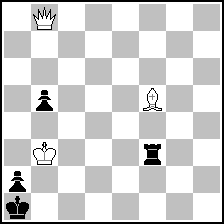 (= 3+4 ) (= 3+4 )
The solution calls for 9.Bd3! (I concede this is the fastest win), but suppose instead, white plays 9.Kc2 -- now what?
9...Rxf4? Qh8 mates
9...Rc3+? Kxc3 mates
9...b4 now, I think, 10.Bd3! wins (not 10.Qxb4? =) against everything (e.g., 10...b3+ 11.Qxb3! ...Rf2+ 12.Kc3! ...Rc2+ and now 13.Kd4! mates in 10).
So, it must be 9...Rf2+
Now suppose white plays 10.Kd3 (intending 11.Ke4, after which it looks easily won)...
What can black do?
10...Rxf5 looks like the intended rejoinder, and it ALMOST works!
In fact, he very easily could have gotten away with this, if it weren't for those danged EGTB's (live by the sword...)!
11.Qh2! (only move) mates in 34.
if 11...b4 12.Kc4! ...b3 13.Qg1+! ...Kb2 14.Qd4+! (all these are only moves!), and now many duals creep in on the cook.
Unless I am badly mistaken (maybe I am the carless one, or my EGTB is wrong?), this seems to reinforce my argument:
How could so many endgame judges be missing these things (might they conspire to bend the rules)?
And before you answer that, ask yourself: if there were a refutation for 9.Kc2, how could it not have been included, as a try, in the solution?
Is it possible that the judges share in the mass misconception that "best/fastest" moves are enough to solve an endgame study (slower alternatives can always be dismissed, when it suits the judge's discretion)?
It's time those who "popularize" the genre (by celebrating flawed problems) shoulder some burden, and help raise the standards!
At the very least, help clarify when a study composer can be allowed to ignore a "slower/non-best" dual.
The problem is still magnificient -- don't get me wrong -- but if 9.Bd3 disappears, so too does the fine try (9.Kb4!? Rxf5 10.Qh8+ Kb1 11.Qh1+ Kb2 12.Qg2+ Kb1 13.Kb3 a1N+!=); and you can't deny the problem is diminished.
| | | (8) Posted by Sarah Hornecker [Friday, Oct 30, 2009 11:09]; edited by Sarah Hornecker [09-10-30] |
Objection to Die Schwalbe 2007-2008, 1st prize, should fall into my competence as co-editor of the magazine so I feel free to reply.
In the diagrammed position, 9.Kc2? fails to Rf2+ 10.Kd3 Rf3+! 11.Ke4 Rxf5! 12.Kxf5 Kb1!
 (= 2+3 ) (= 2+3 )
White has nothing better than 13.Qxb5+ Ka1! and a theoretical draw is reached. Here (one move before) 12.Qh2 doesn't work because of 12...b4 13.Qc2 Rf1 with easy draw.
So the last possibility is 11.Kd2 Rf2+! 12.Kc3 b4+! 13.Kb3 Rf3+ and the main variation doesn't work anymore (for example 14.Bd3 Rxd3+ 15.Kc2 Rc3+) while 14.Kxb4 Rb3+ 15.Kxb3 is stalemate and there are no other ways to improve the position. For example 14.Kc4 b3! and black draws.
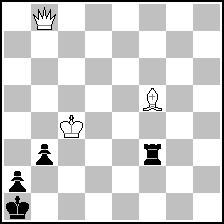 (= 3+4 ) (= 3+4 )
Your objection and my reply will be forwarded to Martin Minski who will also test it.
Best,
Siegfried
PS, 13:19h: Martin Minski sent a mail where he confirms my analysis
PPS, 18:07h: Find the award online here: http://dieschwalbe.de/unserezeitschrift/aktuelledieschwalbe/aktuelleschwalbe.html#inform
| | | (9) Posted by Kevin Begley [Friday, Oct 30, 2009 11:47]; edited by Kevin Begley [09-10-30] |
Siegfried,
I have no objection.
I goofed -- completely missed (right along with Fritz!) that after Kxf5 Kb1! easily draws (not Kb2?).
Beautiful problem.
Sincere apologies to all (Sergiy, Siegfried, Die Schwalbe, the judge!, and the artist!).
My blunder does prove Sergiy's point -- the standards are sometimes very high in endgame studies.
I only wish they were always this high (if I had more faith in ALL awards, I might have kept looking, and found the refutation).
| | | (10) Posted by Sergiy Didukh [Friday, Oct 30, 2009 13:02] |
There are more nice studies dated of 2008. The winners of these magazines Shachova Skladba (J.Mikitovics & J.Polasek), Cheskoslovensky Sach (Ladislav Salai jr), Shakhmatnaya kompozitsia (probably my best study) are magnificent. And somehow I haven’t mentioned any of great names in the genre, but I’m sure they also composed wonderful studies during 2008.
Of course, the variation Kc2 should have been given in my presentation of the study by G.Sonntag. I’m flattering myself (looking at the position with Queen against two pawns) that this study could somehow be suggested to Gunter by my own effort from Nona-2008 (4th prize), though it has completely different ideas.
Comparing studies of the past and the present, I can say that now there are much more studies: more bad studies and more good ones. 'EG' tries to reprint all of them and seldom comments are given.
| | | (11) Posted by Hauke Reddmann [Saturday, Oct 31, 2009 15:22] |
What, pray tell, IS the purpose of the Study of the Year?
a) It is the "best" one. Although three judges have four
opinions, and I don't even dare to compare my compentence
in the area with the esteemed Mr. Roycroft, I'm not
impressed by this one.
b) It is the best one to popularize studies.
OK, OK, then lets discuss this subpoint:
What properties make a study able to popularize the genre
for non-problemists?
Hauke
P.S. Oh, BTW, when a judgement is made usually one can read the
verdict somewhere. So, what made the judge choose this study?
It's only fair to hear him too.
| | | (12) Posted by Joost de Heer [Sunday, Nov 1, 2009 09:40] |
'Study of the year' is for popularising studies.
But let's forget the SOTY context for a second and look at something else that's odd about this study: why did this composition get a special prize in the first place? Nothing new here, as far as I can see.
| | | (13) Posted by Georgy Evseev [Monday, Nov 2, 2009 10:28]; edited by Georgy Evseev [09-11-02] |
Full anticipation with much more content
J.Timman, 1992 (source?)
 (= 9+5 ) (= 9+5 )
1. Bd6+! Kxd6 2. Rxd5+ Ke7 3. Be6 Kxe6 4. Rd8! Bxd8 5. Ra8 Qxa8 6. b7 Qxb7 7. cxd8S+ Kd5 8. Sxb7 Kc4 9. Kf5 Kxc3 and the final with same mate.
Такen from here: http://susanpolgar.blogspot.com/2009/10/chess-study-of-year.html
| | | (14) Posted by Joost de Heer [Monday, Nov 2, 2009 12:13] |
QUOTE
J.Timman, 1992 (source?)
Source was given in the same article: Vrij Nederland 1992.
| | | (15) Posted by Kevin Begley [Tuesday, Nov 3, 2009 04:49]; edited by Kevin Begley [09-11-03] |
Can anybody confirm the anticipation?
If so, in order to properly site Timman's study, I have to ask: what disctinction, if any, did GM Timman's study receive?
I am presently unable to do a careful anticipation search, but a cursory glance through online samples, of EG (circa 1992 -- where GM Timman was listed as a contributing editor and John Roycroft was, of course, the editor) did not reveal such a study.
Are we coming to the point where the protagonist quite forgets "how to speak good English."
I shouldn't telescope with new information arriving, but I do sense a gambit here.
Not sure in which style this sacrifice is worse... but it has all the elements of a well-prepared blunder.
1) That quick lure which dangles on inbalance's hook.
It may encourage chess players to compose EGs -- opportunity tugs harder than flawless beauty.
Plus, this problem's distrubtion system could rival some phone books.
2) The feint...
Michael's comments are spot on -- John Roycroft would have seen these flaws in a blink (let's not fool ourselves).
No need re-read Stress Fractures in Titanium...
3) The bending of the noodles.
4) Haste in play, heartbeat, respiration.
5) Fleeting flickers of confidence in far-away smiles.
And now, this claim... and that moment in the story, when that exclamation connects, and the pieces fall into place...
Chess games are playing within chess games.
| | | (16) Posted by Sarah Hornecker [Tuesday, Nov 3, 2009 05:17] |
Timman got no distinction. Should he? Compared to Pal Benkö's study, his contained nothing much new: Some introduction and a different ending.
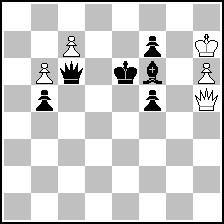 (= 5+6 ) (= 5+6 )
Pal Benkö
Magyar Sakkélet 1987, 1st prize
White wins
1.Qd1! Qa8! 2.Qd8! Bxd8 3.b7 Qxb7 4.cxd8S+ Kd5 5.Sxb7 f4 6.Sa5 Ke4 7.Sb3 Ke3 8.Sd4! b4 9.Kg8 (9.Kg7 also wins. SH) 9...b3 10.h7 b2 11.Sc2+ Ke2 12.Sa3 and white easily wins.
After some time trying to correct "the Ionchev" (Roycroft JT 1978, originally should have gotten 2nd prize but was found to be incorrect) I gave up when I saw the anticipations like this famous study.
 (= 7+4 ) (= 7+4 )
Gia Nadareishvili
Vecherni Leningrad 1965, 1st to 2nd prize
White draws
1.Bc6+ Kxc6 2.Rg8! Qh1! 3.Rg1! Qh8! 4.Rg8! Qxg8 5.f7 Qxf7 6.exd8S+! Kc5 7.Sxf7 draws. It is black now who must play precisely: after 7...Kxc4 white can try 8.Se5+ when only 8...Kd5!! draws.
But imagine that there even was a glimpse of light into the darkness before this, and it might be by most the unusual of those positions.
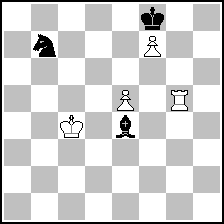 (= 4+3 ) (= 4+3 )
B. Kuzmanovic
Politiken 1957
White wins
1.Kd4 Bh7 2.e6 Sd8 3.Rg8+!! Bxg8 4.e7+!!
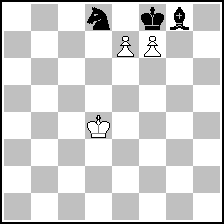 (= 3+3 ) (= 3+3 )
In the end, one can only capture one pawn at the same time - white wins.
| | | (17) Posted by Marjan Kovačević [Tuesday, Nov 3, 2009 14:44] |
The author of the last endgame could have been Branko Kuzmanovic, Serbian endgame composer, who published a lot of his works in the local newspapers. Could it be that the source is misprinted as Politiken, instead of Politika, the Belgrade daily where I work?
| | | (18) Posted by Sarah Hornecker [Tuesday, Nov 3, 2009 16:34]; edited by Sarah Hornecker [09-11-03] |
hhdbiii which I use as source gives tp14 (Politiken) while Politika would be tp07. If there's a mistake, it is not on my end.
Comparison:
Politiken - Danish newspaper, founded October 1 1884. Still exists.
Политика (Politika) - Serbian newspaper, founded January 25 1904. Still exists.
(source: Wikipedia)
Maybe he sent to a Danish newspaper?
Known studies of Branko Kuzmanovic, according to hhdbiii (which I highly recommend until hhdbiv is out):
5k2/1n3P2/8/4P1R1/2K1b3/8/8/8 +
Politiken 1957
2r5/8/1P6/6N1/K1n5/8/5k2/8 =
Politika 1957 (part of a twin)
k4B2/2K5/B2P4/r1bb4/8/N7/8/8 +
Politika 1963
3N2Q1/4K2b/5r1k/5p1q/5P2/8/8/8 =
L'Italia Scacchistica 1965, no.4057
7N/3b4/2p5/8/8/1KPp4/7k/8 =
Problem 1967, no.197, 4th prize
2B5/4p3/8/1b6/4p3/8/7K/1k6 =
Problem 1967, no.204, 4th commendation
I had a very nice talk with Marjan a few months ago. If I remember correctly, he said he has no archive of the publications in Politika (or at least none he can send). So who can shed light on this darkness?
| | | (19) Posted by Marek Kwiatkowski [Tuesday, Nov 3, 2009 22:18] |
The “quasi-dual” 10.Sa5 (Kalandadze’s study) leads to two possible (4-move) maneuvers: Sa5-c6-d4-e2-c1 or Sa5-b7-c5-d3-c1. In my opinion, the second way challenges a sense of the move 10.Sb7-a5. A dual would occur here, if the first way has been shorter than the second one.
The Kalandadze’s study seems to be a work of art.
What does “masterpiece” mean? Some can feel it, others may only say.
Respect, Mr. Roycroft!
Jan Timman’s work is only very similar one. Both are very interesting.
| | | (20) Posted by Sarah Hornecker [Tuesday, Nov 3, 2009 23:50]; edited by Sarah Hornecker [09-11-18] |
QUOTE
What does “masterpiece” mean?
Even though the topic will now go very off-topic, I will still reply.
According to the book by Jonathan Levitt & David Friedgood, a masterpiece is a study that in the most economical way has good flow, high paradox, nice geometry and some depth. Since it is not easy to use this when judging studies, one is best as judge to know a wide variety of classical and some modern studies (which nonetheless can be instant classics).
In my award Schach 2006-2007 I hope to have found a fair judgement (although I'm still unsure about one study that got a shared 5th commendation). Especially interesting points were in anticipations since one study was a correction of an already published one that got originally 2nd honoring mention. In my award - that some might consider hard - it got the same distinction even with added good play. The point was that the original study was incorrect, else it might not have got a distinction.
I gave one prize. The prize went to a study that showed an Allumwandlung (high geometry) with greatest economy.
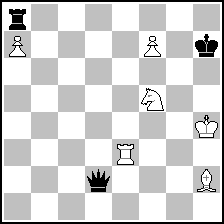 (= 6+3 ) (= 6+3 )
Martin Minski & Gunter Sonntag
Schach 07/2007, no. 16.271, prize
White wins
There were also studies I personally didn't like but I included into the award. On the other hand, some studies that might have won prizes elsewhere got only a commendation. The worst thing left from judging is the bad feeling, however. Often I think I made a misjudgement and should not have included the following study into the award...
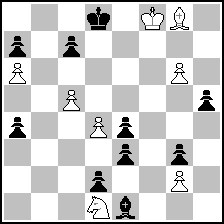 (= 8+10 ) (= 8+10 )
Pietro Rossi
Schach 05/2007, no. 16.228, 5th to 6th commendation
Black to move, white wins
There's an obvious flaw in this study: Bg8 belongs to f7 in the initial position! This would make the sacrifice 2.Bb3 "zweckrein".
Of course, we could define every great achievement as masterpiece. But then we would deny that there are brilliancies that don't achieve anything but still are incredibly interesting. I think the best definition of masterpiece I heard so far is the one by Friedgood and Levitt. At least it influenced me as judge - but not as composer. I was very lucky to have had the comments of Jürgen Bischoff and to have the friendship to the great solver Klaus Rubin. He was helping much in the award by giving opinions from the sight of a solver.
EDIT: November 18, just corrected a typo
| |
Read more... | Page: [Previous] [Next] 1 2
MatPlus.Net  Forum Forum  General General  Thoughts on the Study of the Year... Thoughts on the Study of the Year... |
|
|
|
 ISC 2024
ISC 2024 Forum
Forum  General
General  Thoughts on the Study of the Year...
Thoughts on the Study of the Year... 


